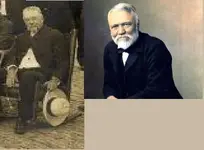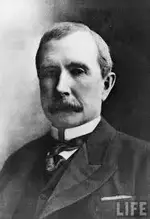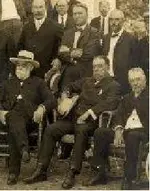TAMMANY HALL SACHEM
Fernando Wood - Wikipedia, the free encyclopedia
Fernando Wood was Chairman of the Committee on Ways and Means in both the 45th and 46th Congress (1877–1881). The Committee of Ways and Means is the chief tax-writing committee of the United States House of Representatives. The Committee has
jurisdiction over all taxation, tariffs, and other revenue-raising measures
Captain George W. Walling pledged his loyalty to the new Metropolitan Police and was ordered to arrest Mayor Wood. Wood refused to submit and when Captain Walling attempted force, New York City Hall was occupied by 300 Municipal policemen, who promptly tossed Captain Walling into the street. Fifty Metropolitans in frock coats and plug hats then marched on City Hall with night sticks in hand. The Municipals swarmed out and routed the Metropolitans. Fifty-two policemen were injured in the New York City Police Riot. ...as in Police beating police with night sticks....

The Metropolitan Police Board called out the National Guard, and the Seventh Regiment surrounded City Hall. A platoon of infantry with fixed bayonets marched into City Hall and surrounded Mayor Wood who then submitted to arrest. Mayor Wood was charged with inciting to riot, released on nominal bail and returned to his office.
The feud continued on through the summer of 1857 a time when the struggle of the k.G.C. was raging in Kansas and Nebraska Territories for control. Constant confrontations between the rival police forces in new York mimic the same struggle for power that was happening in other areas of the country. When a Municipal arrested a criminal, a Metropolitan would come along and release him. At the police station, an arresting officer would find an alderman and a magistrate from the opposing side waiting. A hearing would be held on the spot and the prisoner released on his own recognizance.
Fernando Wood served a second mayoral term in 1860–1862. In 1860 he headed a pro-Southern delegation to the National Democratic Nominating Convention. In January 1861
Wood was one of many New York Democrats sympathetic to the Confederacy, called
'Copperheads' by the staunch Unionists. During his second mayoral term in January 1861, Wood suggested to the New York City Council that
New York secede and declare itself a free city, to continue its profitable cotton trade with the Confederacy. In 1863 he joined Clement Vallandingham in organizing the Peace Democrats and, capitalizing on New York's war weariness and dissatisfaction with the Emancipation Proclamation, won election to Congress for a second time. Except for the years 1865 to 1867, Wood served until 1881 in the House, where he was an ardent opponent of Radical Reconstruction. His greatest success came in achieving tariff reform. Wood died at Hot Springs, Ark., on Feb. 14, 1881.
Read more:
Fernando Wood: Biography from Answers.com
Wood's Democratic machine was concerned to maintain the revenues (which depended on Southern cotton) that maintained the patronage. Wood's suggestion was greeted with derision by the Common Council. Tammany Hall was highly factionalized until after the Civil War. Wood headed his own organization named Mozart Hall, not Tammany Hall. New York City commercial interests wanted to retain their relations with the South, but within the framework of the Constitution.
Wood's brother Benjamin Wood purchased the New York Daily News (not to be confused with the current New York Daily News, which was founded in 1919), supporting Stephen A. Douglas, and was elected to Congress, where he made a name as an opponent of pursuing the American Civil War. In 1861 the federal government effectively shut down the paper (by suspending its delivery via the postal service) as being sympathetic with the enemy. Wood was able to re-open the paper 18 months later. During the interval, he wrote one novel: “Fort Lafayette or, Love and Secession.”
Where did all of that money come from?
Everything Was Fake but Her Wealth | History | Smithsonian
L.C.








 The Metropolitan Police Board called out the National Guard, and the Seventh Regiment surrounded City Hall. A platoon of infantry with fixed bayonets marched into City Hall and surrounded Mayor Wood who then submitted to arrest. Mayor Wood was charged with inciting to riot, released on nominal bail and returned to his office.
The Metropolitan Police Board called out the National Guard, and the Seventh Regiment surrounded City Hall. A platoon of infantry with fixed bayonets marched into City Hall and surrounded Mayor Wood who then submitted to arrest. Mayor Wood was charged with inciting to riot, released on nominal bail and returned to his office.